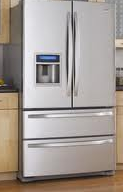Refrigeration is the process of transferring heat from low temperature reservoir to the high temperature reservoir. As it is against the natural flow of heat it requires power to enable this transfer. Process of refrigeration helps to chill water, make ice and preserve fruits, vegetables and other food items. At temperatures below 4 degree Celsius, the bacteria cease to exist and hence the food items remain safe and fresh.
 Generally a refrigeration system includes components like Freon gas, compressor, condenser, evaporator, thermostat etc, which are all enclosed in a casing. There is a long thin tube at the bottom or back of the refrigerator which is connected to a pump, which is powered by an electric motor. Inside the tube there is gas called HFC-134a, also called tetrafluoroethane, the pump pushes this liquid gas through the coils in the freezer area and here the chemical is turned in to vapor and this vapor absorbs the heat in the freezer compartment. As it does this, the coils get colder and the freezer begins to get colder. Pump then sucks the HFC-134a which is in the vapor form and forces it through thinner pipes which are on the outside of the refrigerator. By compressing it, the vapor turns back into a liquid and heat is given off and is absorbed by the air around it. Once the chemical passes through the outside coils, the liquid is ready to go back through the freezer and refrigerator over and over.
Generally a refrigeration system includes components like Freon gas, compressor, condenser, evaporator, thermostat etc, which are all enclosed in a casing. There is a long thin tube at the bottom or back of the refrigerator which is connected to a pump, which is powered by an electric motor. Inside the tube there is gas called HFC-134a, also called tetrafluoroethane, the pump pushes this liquid gas through the coils in the freezer area and here the chemical is turned in to vapor and this vapor absorbs the heat in the freezer compartment. As it does this, the coils get colder and the freezer begins to get colder. Pump then sucks the HFC-134a which is in the vapor form and forces it through thinner pipes which are on the outside of the refrigerator. By compressing it, the vapor turns back into a liquid and heat is given off and is absorbed by the air around it. Once the chemical passes through the outside coils, the liquid is ready to go back through the freezer and refrigerator over and over.
In the freezer section of the refrigerator, temperature below zero degrees Celsius is maintained and in the main body of the refrigerator temperature ranging from 0 to 4 degree Celsius and the temperature maintained in this section depends on the distance of the compartment from the freezer section. To avoid the external heat entering in the fridge, the refrigerators are covered with the insulating materials and the most commonly used insulating material used is PUF.
